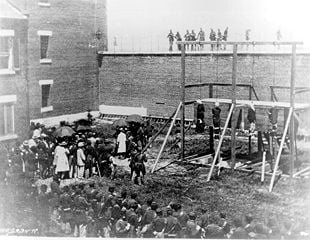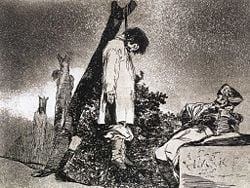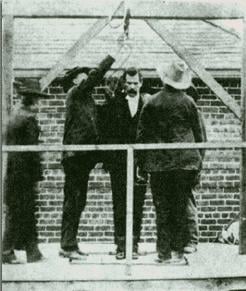Hanging
Hanging is the suspension of a person by a ligature, usually a cord wrapped around the neck, causing death. Throughout history it has been used as a form of capital punishment. Some countries still use it today. It is also a common method of committing suicide.
Terminology
The OED states that hanging in this sense is specifically to put to death by suspension by the neck, although it formerly also referred to crucifixion.
The past tense and past participle in English is hanged, whereas all other senses of the verb to hang use hung (although hung is used by some, particularly those in south-east England).
For lack of a better term, "hanging" has also been used to describe a method of suicide in which a person applies a ligature to the neck and brings about unconsciousness and then death, by means of partial suspension or partial weight-bearing on the ligature. This method has been most often used in prisons or other institutions, where full suspension support is difficult to devise. The earliest known use in this sense was in A.D. 1300. [1]
Methods of judicial hanging
The first record of use is in the Persian Empire approximately 2,500 years ago,[2]. There are four methods of performing a judicial hanging — the short drop, suspension hanging, the standard drop, and the long drop. A mechanised form of hanging, the upright jerker, was also experimented with in the 19th century.
Short drop
The short drop is done by placing the condemned person on the back of a cart, horse, or other vehicle, with the noose around his neck. The vehicle is then moved away leaving the person dangling from the rope. Prior to 1850, it was the main method used. It is still used widely in Middle Eastern countries.[3] A ladder was also commonly used with the condemned being forced to ascend, after which the noose was tied and the ladder pulled away or turned, leaving the victim hanging.
Suspension hanging
Suspension hanging is similar, except the gallows themselves are movable, so that the noose can be raised once the condemned is in place. This method is currently used in Iran, where tank gun barrels or mobile cranes are used to hoist the condemned into the air. Similar methods involve running the rope through a pulley to allow raising of the person.

Standard drop
The standard drop, which arrived as calculated in English units, involves a drop of between four to six feet (1.2 to 1.8 meters) and came into use in the mid 19th century in English-speaking countries and those where judicial systems were under English influence. It was considered an advance on the short drop because it was intended to be sufficient to break the person's neck, causing immediate paralysis and immobilization (and perhaps immediate unconsciousness).
Long drop
This process, also known as the measured drop, was introduced in 1872 by William Marwood as a scientific advancement to the standard drop. Instead of everyone falling the same standard distance, the person's weight was used to determine how much slack would be provided in the rope so that the distance dropped would be enough to ensure that the neck was broken.
Prior to 1892, the drop was between four and ten feet (about one to three meters), depending on the weight of the body, and was calculated to deliver a force of 1,260 lbf (5,600 newtons or 572 kgf), which fractured the neck at either the 2nd and 3rd or 4th and 5th cervical vertebrae. However, this force resulted in some decapitations, such as the famous cases of "Black Jack" Tom Ketchum in New Mexico in 1901 and Barzan Ibrahim al-Tikriti in 2007. Between 1892 and 1913, the length of the drop was shortened to avoid decapitation. After 1913, other factors were also taken into account, and the force delivered was reduced to about 1,000 lbf (4,400 N or 450 kgf).
Suicide
Suspension hanging is a common method of suicide. The materials necessary for suicide by hanging are relatively easily available to the average person, compared with firearms or lethal poison. Full suspension is not required, and for this reason hanging is especially commonplace among suicidal prisoners. A type of hanging comparable to full suspension hanging may be obtained by self-strangulation using a ligature of the neck and only partial weight of the body (partial suspension). This method is dependent on unconsciousness produced by arterial blood flow restriction while the breath is held.
- In Canada, hanging is the second most common method of suicide,[4] after suffocation.
- In the U.S., hanging is the second most common method of suicide, after firearms, [5].
- In Great Britain, where firearms are less easily available, as of 2001 hanging was the most common method among men and the second-most commonplace among women (after poisoning).[6]
Medical effects

A hanging may cause one or more of the following medical conditions:
- Close the carotid arteries
- Close the jugular veins
- Induce carotid reflex, which reduces heartbeat when the pressure in the carotid arteries is high, causing cardiac arrest
- Break the neck (cervical fracture) causing traumatic spinal cord injury
- Close the airway causing cerebral ischemia
- Decapitation
The cause of death in hanging depends on the conditions related to the event. When the body is released from a relatively high position, death is usually caused by severing the spinal cord between C1 and C2, which may be functional decapitation. High cervical fracture frequently occurs in judicial hangings, and in fact the C1-C2 fracture has been called the "Hangman's fracture" in medicine, even when it occurs in other circumstances. Usually, accidental C1-C2 fracture victims do not immediately become unconscious; instead death occurs after some minutes, from asphyxia.[citation needed]
In the absence of fracture and dislocation, occlusion of blood vessels becomes the major cause of death. Obstruction of venous drainage of the brain via occlusion of the internal jugular veins leads to cerebral oedema and then cerebral ischemia. Other processes that have been suggested to contribute are vagal collapse (via mechanical stimulation of the carotid sinus), and compromise of the cerebral blood flow by obstruction of the carotid arteries, even though their obstruction requires far more force than the obstruction of jugular veins, since they are seated deeper and they contain blood in much higher pressure compared to the jugular veins. Only 31 newtons (7 lbf or 3.2 kgf) of pressure may be enough to constrict the carotid arteries to the point of rapid unconsciousness.[citation needed]
Where death has been caused by blocking the veins, the face will typically have become engorged and cyanotic (turned blue through lack of oxygen). There will be the classic sign of strangulation—petechiae—little blood marks on the face and in the eyes from burst blood capillaries. The tongue may protrude. Where death has occurred through carotid artery obstruction or cervical fracture, the face will typically be pale in colour and not show petechiae. There exist many reports and pictures of actual short drop hangings which seem to show that the person died quickly, while others indicate a slow and agonising death by strangulation. [7]
When cerebral circulation is severely compromised by any mechanism, arterial or venous, death occurs over four or more minutes from cerebral hypoxia, although the heart may continue to beat for some period after the brain can no longer be resuscitated. The time of death in such cases is a matter of convention. In judicial hangings, death is pronounced at cardiac arrest, which may occur at times from several minutes up to 15 minutes or longer after hanging. During suspension, once the prisoner has lapsed into unconsciousness, rippling movements of the body and limbs may occur for some time which are usually attributed to nervous and muscular reflexes. In Britain, it was normal to leave the body suspended for an hour to ensure death.
There is a popular myth about sexual stimulation of hanged men, because of the apparent erection some exhibited. The effect is attributed to gravity causing the blood to settle in the legs and lower torso, thereby engorging the penis.
After death, the body typically shows marks of suspension: bruising and rope marks on the neck. Forensic experts may often be able to tell if hanging is suicide or homicide, as each leaves a distinctive ligature mark. One of the hints they use is the hyoid bone. If broken, it often means the person has been murdered by manual choking. Also, there have been cases of autoerotic asphyxiation leading to death. Children have accidentally died playing the choking game.
Hanging as a Method of Capital Punishment
Hanging has come to be seen as a brutal method of execution and is rarely practiced anymore. Hanging was another method of execution employed by the Nazis during World War II. In a newspaper interview in 1957, Nikita Khrushchev commented regarding the failed late-1956 Hungarian revolution that "support by United States ... is rather in the nature of the support that the rope gives to a hanged man."[8]. In keeping with the metaphor, the prime minister of Hungary during the 1956 revolution, Imre Nagy, was secretly tried, executed by hanging, and buried unceremoniously by the new Soviet-backed Hungarian government, in 1958. Nagy was later publically rehabilitated by Hungary.[9]
Canada used hangings as late as 1962.[10] The Indian Supreme Court ruled that capital punishment would only be used in extreme cases.[11] One such example is that of Dhananjoy Chatterjee, who was convicted of the 1990 murder and rape of a 14 year old girl in Kolkata in India and was subsequently hanged.[12] The last public hanging legally conducted in the United States (and also the last public execution in the United States) was that of Rainey Bethea, who was publicly hanged on August 14 1936, in Owensboro, Kentucky.
Iran is one country that still uses hangings. On July 19 2005, two boys, Mahmoud Asgari and Ayaz Marhoni, ages 15 and 17 respectively, who had been discovered to be having homosexual relations, were publicly hanged at Edalat (Justice) Square in Mashhad, on charges of homosexuality and rape. [13][14][15] As one of several means of capital punishment in Iran, hangings are carried out by using an automotive telescoping crane to hoist the condemned aloft. The death penalty is used for many offenses and is the only punishment for rape, murder and child molestation, with all hangings taking place in public. Iraq also uses hanging. In September 2005, three murderers were the first people to be executed since the downfall of Saddam Hussein. Then on March 9 2006, an official of Iraq's Supreme Judicial Council confirmed that Iraqi authorities had executed the first insurgents by hanging.[16]
Notable Examples of Hangings
- Bulgaria's national hero, Vasil Levski, was executed by hanging by the Ottoman court in Sofia in 1873.
- Brazilian national hero Tiradentes (1792) was killed by hanging.
- Nathuram Godse, Mohandas Gandhi’s assassin, was executed by hanging in 1949.
- Saddam Hussein the former leader of Iraq, was hanged after being found guilty of brutal executions
- Nazi war criminal Adolf Eichmann was hanged in Israel after being captured by Mossad agents in Argentina in 1961.
- Those convicted of war crimes at the Nuremberg Trials following World War II were also hanged.
- During the Salem Witch Trials many accused of witchcraft were hanged.
ReferencesISBN links support NWE through referral fees
- ↑ OED Entry, URL http://dictionary.oed.com/cgi/entry/50102310?query_type=word&queryword=hang&first=1&max_to_show=10&sort_type=alpha&result_place=4&search_id=ytyG-jULKok-8630&hilite=50102310
- ↑ The process of judicial hanging, Capital Punishment U.K., www.richard.clark32.btinternet.co.uk
- ↑ International Noose Washington Post. Retrieved April 9, 2007.
- ↑ "Statistics about suicide", WrongDiagnosis.com.
- ↑ Suicide Statistics. URL accessed on 2006-05-16.
- ↑ Trends in suicide by method in England and Wales, 1979 to 2001 (PDF), Office of National Statistics. URL accessed on 2006-05-16.
- ↑ How hanging causes death. Retrieved 2006-04-27.
- ↑ Simpson, James (1997). Simpson's Contemporary Quotations. Collins, 672 pages. ISBN 0-06-270137-1.
- ↑ Hungary: U.S. President To Honor 1956 Uprising Radio Free Europe. Retrieved April 10, 2007.
- ↑ Susan Munroe, History of Capital Punishment in Canada, About: Canada Online,
- ↑ Sakhrani, Monica; Adenwalla, Maharukh; Economic & Political Weekly, "Death Penalty - Case for Its Abolition"
- ↑ Kumara, Sarath; World Socialist Web Site; "West Bengal carries out first hanging in India in a decade"
- ↑ Iran executes 2 gay teenagers. Retrieved 2006-04-27.
- ↑ Exclusive interview with gay activists in Iran on situation of gays, recent executions of gay teens and the future. Retrieved 2006-04-27.
- ↑ Iran 'must stop youth executions' BBC News. Retrieved April 10, 2007.
- ↑ "More bombs bring death to Iraq", Mail & Guardian Online, 2006-03-10. Retrieved 2006-04-27.
Credits
New World Encyclopedia writers and editors rewrote and completed the Wikipedia article in accordance with New World Encyclopedia standards. This article abides by terms of the Creative Commons CC-by-sa 3.0 License (CC-by-sa), which may be used and disseminated with proper attribution. Credit is due under the terms of this license that can reference both the New World Encyclopedia contributors and the selfless volunteer contributors of the Wikimedia Foundation. To cite this article click here for a list of acceptable citing formats.The history of earlier contributions by wikipedians is accessible to researchers here:
The history of this article since it was imported to New World Encyclopedia:
Note: Some restrictions may apply to use of individual images which are separately licensed.


